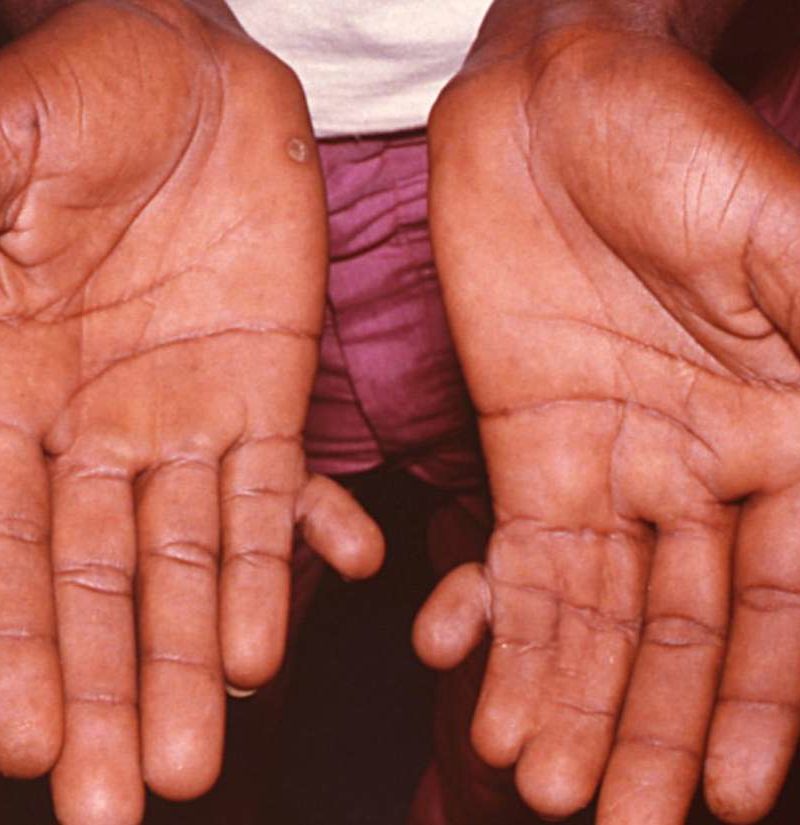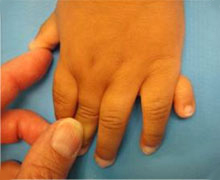extra finger on baby removal
In several babies the extra digit can be poorly formed and smaller than the others. It affects boys and girls equally.

Extra Digits What Happens After Treatment Congenital Hand And Arm Differences Washington University In St Louis
Occasionally it contains bone without joints.

. Polydactyly usually is genetic. Sometimes the extra finger contains bones but not joints. Polydactyly is a condition where someone is born with one or more extra fingers or toes.
Webbed finger or toe repair refers to corrective or reconstructive surgery performed to repair webbed fingers or toes also called syndactyly. Removal of an extra little finger or toe is usually a simple procedure. Your babys healthcare provider may take an X-ray to see how much bone is involved.
Messages 4456 Location Milwaukee WI Best answers 0. The extra digit is usually a small piece of soft tissue that can be removed. In a September 2012 episode of the show Alana Honey Boo Boo Thompson joked about her nieces extra finger saying I wish I had an extra finger so then I.
The removal may be necessary if the extra finger or toe causes complications or interferes with the hand or foot functions. Polydactyly literally means extra digits When your child is born with an extra finger or digit the Childrens Health specialists at University of Missouri Childrens Hospital are here to evaluate him or her and create an individualized treatment plan. Syndactyly can also be corrected surgically.
Aug 7 2012 6 11200. The treatment involves the surgical removal of the extra digit. After a short time the extra digit will fall off similar to how a newborn babys.
Polydactyly is one of the most common variations on the basic growth pattern of the hand. Infection is also a risk but no more than any other small cut or graze. Polydactyly is usually treated in early childhood with the removal of the extra finger or toe.
An extra finger is often a small piece of soft tissue that can be simply removed. Bastidas perfers to remove the extra finger sharply under local anesthesia in the office removing the. The condition in which people possess an extra finger or toe ie a supernumerary digit is called Polydactyly.
Polydactyly is not something that rarely occurs in babies but it is a common phenomenon in which a baby may have one or more fingers or toes in his body. Arrangements are usually made so that the baby is delivered at a. If the extra digit is not attached by any bones a vascular clip may be used to remove it.
Our midwife informed us that nubbin-fingers like my sons could simply be surgically removed or tied off like a skin tag you may see this described as a ligation with a piece of. Why I told everyone on Facebook about my babys birth defect The main options for treatment are to surgically remove the extra digits or to leave them intact. It can occur on one or both hands or feet.
A complete working finger or toe. The name comes from the Greek poly many and dactylos finger. These extra digits can be made up of one or more of the following.
Rarely it may be a complete functioning digit. We will work with you and your child throughout the entire treatment process from diagnosis to possible surgery to aftercare. The extra fingers or toes may usually be present next to the big toe thumb little toe or little finger.
Polydactyly refers to extra digits - in the hand extra fingers or thumbs. If two extra digits consisting of soft tissue only were removed from infants right foot would the code be 11200 removal of up to 15 skin tags or 11200-RT AND 11200-59. The extra finger much like the stump at a babys belly button will drop off but always leaves a tell tell sign of extra skin which persists into adulthood.
The extra digit may be connected by skin muscle or bone. The extra digit is called a supernumerary digit. Extra Digits Polydactyly Polydactyly is the most common congenital hand deformity.
Some parents may prefer removal for cosmetic reasons. The extra digit is most common on the ulnar little finger side of the hand less common on the radial side and very rarely within the middle three digits. There are many different forms of polydactyly ranging from.
Skin soft tissue and bone with joint ligament and tendon. The hand forms between 26 and 54 days of. Now surgery is preferred.
Removing an extra little finger can be fairly simple if the extra finger is connected to the rest of the hand by only a small skin bridge. The vascular clip attaches to the extra digit and cuts off blood flow to it. The extra digit may range from a small bump to a fully developed working finger or toe.
The extra digit is clipped or tied right where it joins the hand and it will then shrivel and fall off over a period of about two weeks similar to how the umbilical cord is clipped at birth. Antibiotics are only given if the operation site becomes infected. Polydactyly can be corrected by surgical removal of the extra digit or partial digit.
In the past nubbins were usually just tied off but this often left a bump. An extra little finger is the most common form of polydactyly eight times more common than any other type. A baby born with polydactyly has more than five fingers on one hand.
Bleeding is a risk with any type of operation and with extra finger removal a small amount of oozing is normal. If the extra digit has no potential to cause problems it may be left intact. A small raised bump or a piece of skin that looks like a small finger or toe that isnt fully formed nubbin.
It is best to have the extra toes or fingers surgically removed. Polydactyly is a condition in which a baby is born with extra fingers or toes. The extra digit toe or finger may be poorly developed or fully formed.
Polydactyly refers to extra fingers or toes that are present at birth. For children with ulnar polydactyly the extra pinky finger may be removed through surgery or if the finger is attached by soft tissue by using a suture or a clip to stop blood flow to the digit so that it falls off similar to the stump of a babys belly button. It may look like a finger thats only attached by a small stalk of skin.
Polydactyly on babies occurs in 1 in every 1000 babies and is a congenital condition where the baby has an extra finger or toe. If there is more bleeding applying pressure to the area is usually all that is needed to stop it. This can be done in.
Extra digits occur during the normal development of the hand. This digit may look like a. Most often its smaller than the other digits and not well formed.
There is a more difficult and rigid surgery required more of a reconstruction rather than simply a removal of the extra digit. A small extra bump on the side of the hand a finger which widens to end in two fingertips. Extra digits on the thumb side of the hand or what we call radial polydactyly are more complex by nature.
/https://www.thestar.com/content/dam/thestar/life/2015/09/19/its-natural-but-an-extra-finger-will-still-draw-attention-ethically-speaking/polydactyly.jpg)
It S Natural But An Extra Finger Will Still Draw Attention Ethically Speaking The Star

Extra Digits What Happens After Treatment Congenital Hand And Arm Differences Washington University In St Louis

Extra Digits What Happens After Treatment Congenital Hand And Arm Differences Washington University In St Louis

Polydactyly Overview Surgical Treatment And Care At Home

To Tie Or Not To Tie The Dilemma Of The Supernumerary Digit Consultant360

Polydactyly Symptoms Causes And Treatments

Extra Digits What Happens After Treatment Congenital Hand And Arm Differences Washington University In St Louis

